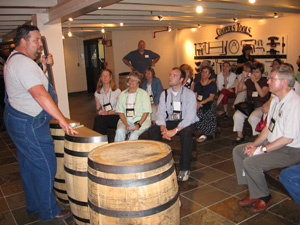
Historic Distilleries
Tennessee’s natural limestone springs, ample timber, and fertile soil for growing grain have made the state an ideal location for whiskey production. Whiskey was an important part of frontier life as both an easily portable diet staple and a medicinal drug. Distilling began as an additional activity on many farms and grew to a major industry in Tennessee by the middle of the nineteenth century. Jack Daniel and George Dickel, the best-known Tennessee distilleries, have long histories. Some of the earliest distilleries in the state, however, were established in Robertson County.
Distilleries in Robertson County date back to the early 1790s, when settlers Thomas Woodard and Arthur Pitt established small stills on their property. Their sons continued the operation and developed whiskey production into a prosperous business. Wiley Woodard inherited his father’s farm and distillery in 1836 and had doubled his whiskey sales by 1841. Soon he was shipping large quantities of whiskey throughout Tennessee and other southern states. Wilson Pitt, Arthur’s son, experienced similar success. As the whiskey industry soared, competition increased. Charles Nelson’s distillery in Greenbriar became Woodward and Pitt’s largest competitor, producing over eight thousand barrels of whiskey per year. Business began to decline in the 1880s as tobacco surpassed whiskey in production, and anti-whiskey pressure rose from temperance groups. State and then national prohibition stopped the production of whiskey altogether, and the industry never resurfaced in Robertson County. Several extant buildings of the Pitt Distillery are listed in the National Register of Historic Places.
Jasper “Jack” Newton Daniel, born in 1848 near Lynchburg in Moore County, began working at a local distillery at age twelve and became a full partner with its owner, Dan Call, at age fifteen. In 1866 Daniel bought Call’s interest in the business and established a distillery on five hundred acres near his birthplace. Daniel’s business prospered, and his product won national acclaim by taking a gold medal at the 1904 Louisiana Purchase Exposition in St. Louis. Although he never married, Daniel kept his business in the family by transferring it to his nephew Lem Motlow four years before his death in 1911. Motlow moved the business to St. Louis in 1910 after prohibition was enacted in Tennessee. Following the repeal of national prohibition, Motlow campaigned to reestablish the distillery in Moore County, which had chosen to remain “dry.” In 1938 county citizens voted in a close race to allow the company to manufacture whiskey in Lynchburg. The Jack Daniel Distillery has remained in Lynchburg and is now one of the nation’s oldest leading distilleries; it is listed in the National Register of Historic Places.
Another leading distillery is that of George A. Dickel & Co. in Tullahoma. In the late 1860s successful Nashville merchant George A. Dickel formed a partnership with the Schwab and Davis families of Nashville and began to market whiskey, which they obtained from several regional sources. The most popular brand was a whiskey from a distillery along Cascade Creek in Coffee County. An astute businessman, Dickel had become familiar with Nashvillians’ taste in whiskey and developed a popular recipe. After his death in 1894, Dickel’s wife Augusta and his partners managed the business. During prohibition the company moved to Louisville and continued to produce its product under a medicinal license. In a situation similar to that of the Jack Daniel Distillery, Dickel’s original home of Coffee County remained “dry” after the repeal of prohibition, necessitating a special referendum to approve the manufacture of whiskey locally. Approval came in 1958, and George Dickel whiskey is still manufactured at a distillery outside of Tullahoma.



